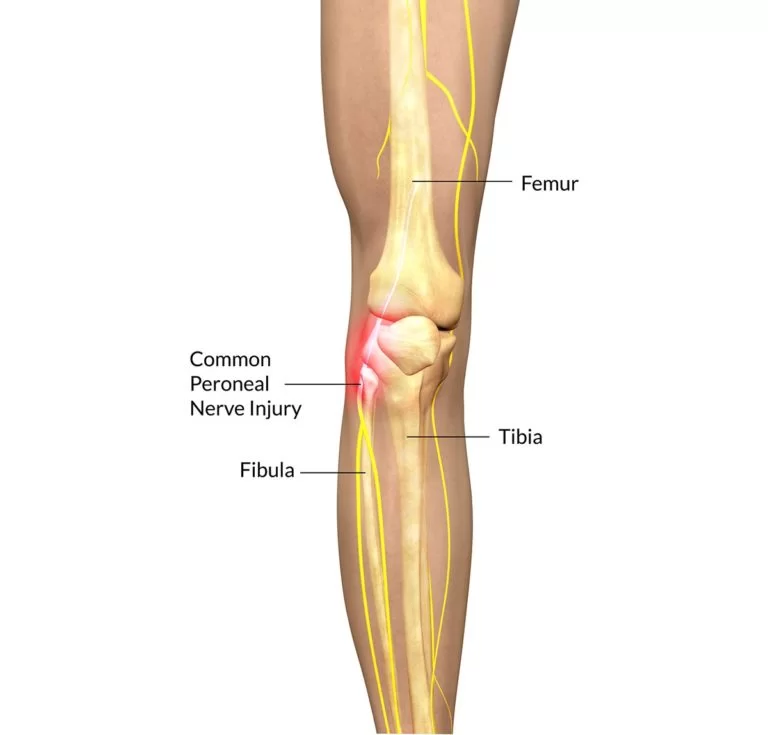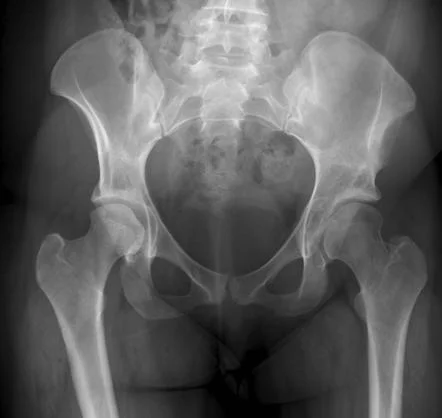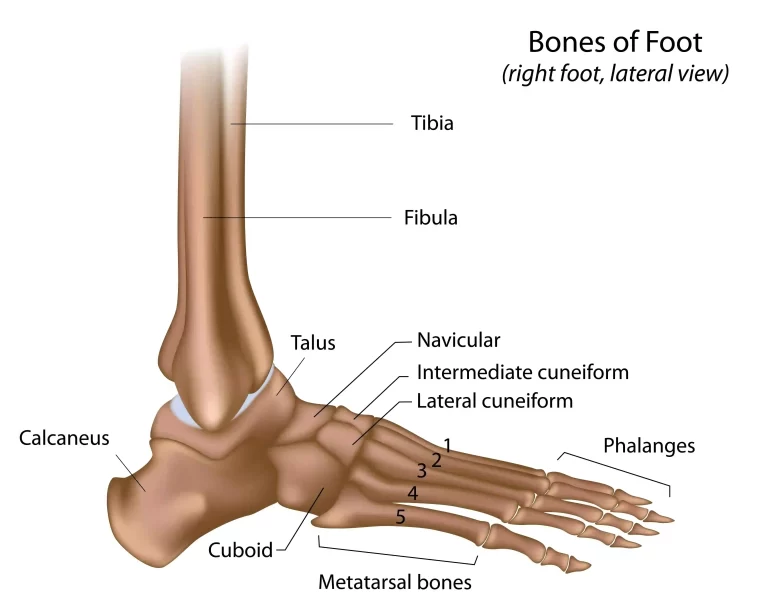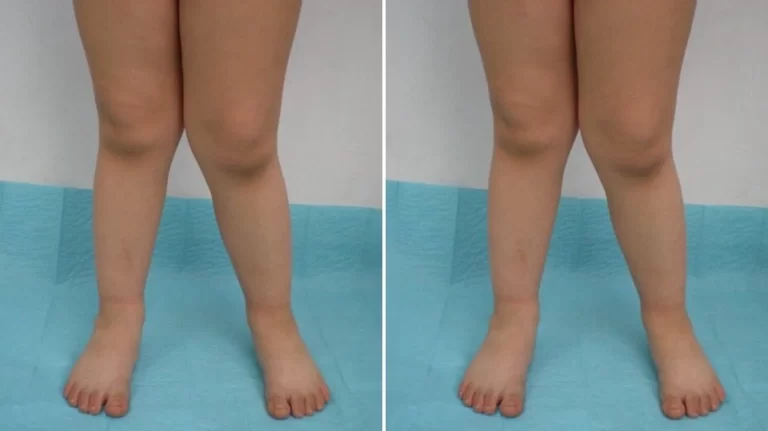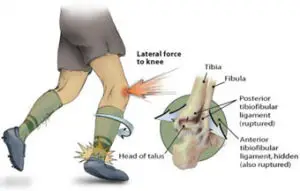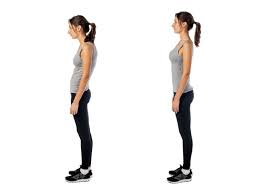Bone Spur On Foot
Introduction
Bone spurs are bony protrusions on the underside of the heel bone caused by a buildup of calcium. On an X-ray, a bone spur may extend up to half an inch forward. In cases where no detectable X-ray evidence is present, the condition is sometimes called “Bone spur syndrome.”
Bone spurs can hurt the heel, even though they are usually painless. They are commonly linked to the painful inflammation known as plantar fasciitis, which affects the plantar fascia, the fibrous band of connective tissue that runs along the bottom of the foot, joining the heel bone to the foot’s ball.
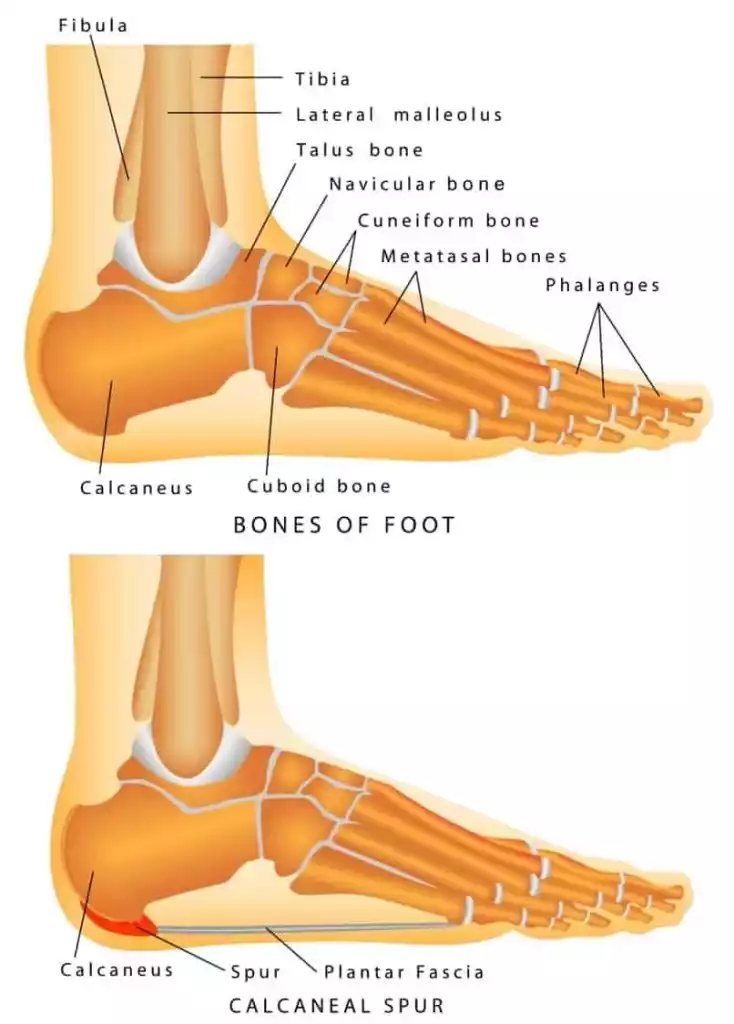
Anatomy
A bone spur, also known as a heel spur, protrudes from the bottom of your heel where your heel bone joins the plantar fascia, the ligament that runs from your heel to the ball of your foot. 15% of people have bone spurs.
Over time, bone spurs grow. Until they seek treatment for heel pain, the majority of people are unaware that they have a heel spur. Although surgery is a viable option for removing bone spurs, medical professionals advise non-surgical methods to alleviate bone spur symptoms.
Osteophytes can grow from any bone, but they are most prevalent in the following:
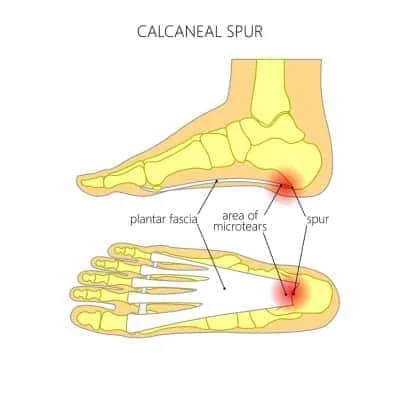
- Foot, particularly the big toe, ankle, and heel (heel spurs or calcaneal spurs)
- Hand or finger
- Hip
- Knee
- Neck
- Shoulder
- Spine
Cause
Usually resulting from tendinitis or degenerative arthritis (also known as osteoarthritis), bone spurs are the result of localized inflammation. This inflammation causes the bone-forming cells to produce more bone in this region, which eventually results in the formation of a spur or bony prominence.
- For instance, one of the most frequent causes of spinal bone spurs is inflammation of the ligament encircling a degenerating disc between the vertebrae, the bony components of the spine.
- A bone spur at the rear of the heel bone (the calcaneus bone) may develop as a result of Achilles tendon inflammation.
- A bone spur at the base of the heel bone can result from plantar fasciitis, an inflammation of the tissue on the bottom of the foot. Sometimes, these bone spurs are referred to as heel spurs.
An osteophyte is the term used in medicine to describe a bone spur. Rarely, congenital disorders may result in bone spurs. One variety of these congenital spurs is an osteochondroma. Where there is inflammation or damage to the surrounding tendons or cartilage, bone spurs form. Bone spurs frequently occur in the rear, or sole, of the foot’s heel bone, around cartilage-degenerating joints, and in the spine next to degenerating discs.
Risk Factors
- Age: The chance of developing a bone spur increases with age. Age-related cartilage degradation causes the body to produce more bone to rebuild damaged cartilage gradually.
- Physical activity: Frequent exercise increases your energy and aids in maintaining a healthy weight. However, it may also increase the strain on your feet, increasing your chance of developing bone spurs.
- Wearing tight shoes: Your toes may become pinched by tight shoes, which also put constant strain on your feet.
- Injury: Following a fracture or a minor injury such as a bruise, bone spurs may form.
- Being overweight: Carrying too much weight increases the strain on your feet and other bones. Your cartilage may deteriorate more quickly due to developing a bone spur.
- Flat feet: When you stand, your entire foot may come into contact with the floor if you have a low or nonexistent arch in your feet. This puts additional strain on your joints and can lead to several issues, including bone spurs, blisters, bunions, and hammer toe.
Symptoms
Not many people are aware that they have bone spurs. Spurs become symptomatic when they:
- Press on the nerves in the vicinity.
- Limit your range of motion.
- Rub up against adjacent tissues or bones.
- Areas that are rough or uneven, particularly in the fingers or toes.
- Numbness and weakness, particularly in the legs if spurs are present in the spine.
- Heel pain or discomfort close to the injured joint.
- Decreased joint range of motion (how far it moves).
- Rigidity.
- Swelling of a nearby tendon is known as tendonitis.
- Tendon tears, such as a shoulder rotator cuff tear.
Diagnosis
Examination
Your doctor will examine your foot after you have discussed your concerns and described your symptoms. They’ll search for these indications:
- A particularly sore spot on your foot that is directly in front of your heel bone
- A flat foot or a high arch
- Restricted ankle dorsiflexion, or “up” motion
- The lack of signs and symptoms of other illnesses like plantar nerve entrapment or insertional Achilles tendinitis
Radiology
X-rays produce distinct pictures of bones. They help exclude conditions like arthritis or fractures as potential sources of heel pain.
An X-ray may reveal bone spurs. Long-term (long-lasting) tension on the plantar fascia insertion—the location on the heel bone where the plantar fascia attaches—can result in a bone spur. On the other hand, heel pain is uncommon in those who have bone spurs on their heels. The pain associated with plantar fasciitis can be managed without removing heel bone spurs because they are not the cause of the condition.
Other Imaging Tests
It is not common practice to use other imaging tests, such as ultrasound and magnetic resonance imaging (MRI), for diagnosis. Seldom are they arranged in order.
If the first treatments do not relieve your heel pain, or if your doctor suspects that another issue is the source of your heel pain, an MRI scan may be performed.
Treatment
Non-Surgical Treatments
Resting may not have a significant effect on the heel pain brought on by bone spur on the foot. After a restful night, walking may exacerbate pain because the plantar fascia abruptly stretches and tugs on the heel. The more you walk, the less painful it usually is. However, a prolonged period of rest or a lot of walking may cause you to experience pain again.
Over-the-counter drugs like acetaminophen (Tylenol), ibuprofen (Advil), or naproxen (Aleve) may help treat heel pain. Many times, biomechanical imbalances that lead to heel and arch pain can be resolved with a functional orthotic device. In certain situations, a corticosteroid injection may be administered to reduce localized inflammation.
See a doctor if your heel pain doesn’t go away after more than a month. They might suggest conservative measures like:
- Stretching exercises
- Shoe recommendations
- Strapping or taping strained tendons and muscles
- Shoe inserts or orthotic devices
- Physical therapy Treatment
- Night splints
Ice packs for bone spur
You can reduce pain and swelling in your feet naturally by applying a cold compress. At least ten minutes should be spent at a time with an ice pack or frozen water bottle applied to your foot. Put the bag on top of your toes if you have a toe bone spur.
Vitamins and supplements
Minerals and vitamins are a vital line of defense against bone spurs. Make sure you are not deficient in calcium especially if you have osteoarthritis. You should also make sure that your levels of magnesium and vitamin D are within the ideal range because these nutrients are necessary for the absorption of calcium. You can typically get these vitamins from your diet. However, consult your physician to find out if supplements are appropriate for you if you exhibit deficiencies.
Massage therapy
Pain management and natural pain relief are two benefits of massage therapy. A massage therapist may work on the calf muscles to relieve the pain that comes with a heel bone spur. This increases blood flow, which relaxes the calf muscle and lessens the strain on the foot.
You can give yourself a self-massage by rolling a small ball across the bottom of your foot. You can do this as you watch television on the couch or while working at a desk. This is a widely used technique for providing both short-term and long-term relief.
Surgery
Nonsurgical treatments improve the condition of over 90% of patients. To relieve pain and regain mobility, surgery might be required if conservative treatment for heel spurs is ineffective after nine to twelve months.
For bone spur pain, two surgical options are available.
Release of the plantar fascia
Plantar fasciitis can sometimes result in bone spurs on the foot. The fibrous tissue called the plantar fascia, which connects your toes to your heel pain, is inflamed in this case.
An excessive amount of strain on the plantar fascia may result in a bone spur in the foot. bone spurs are present in about 50% of patients with plantar fasciitis. However, this bony growth isn’t always the source of their foot pain. It frequently results from plantar fascia inflammation.
A surgeon may execute a surgical procedure known as plantar fascia release to relieve pain. To reduce strain and inflammation in the tissue, a portion of the plantar fascia ligament is cut. This is an outpatient procedure that can be done as an endoscopy or an open surgery.
In an open (also known as traditional) surgery, the surgeon makes a large incision to finish the procedure after using a scalpel to cut the affected area. Conversely, endoscopic surgery involves the least amount of invasiveness.
To perform the surgery, this entails making one or more smaller incisions and then passing tiny surgical instruments through the opening.
Removal of the bone spur
The bone spur may be removed entirely by your surgeon during plantar fascia release surgery. Not every case requires surgery to remove a bone spur. Although these surgical procedures are not common these days, they remain an option in the event of a larger or painful spur that is felt beneath the skin.
Either an open surgery or an endoscopic surgery is used to finish this procedure. Using surgical instruments, your surgeon makes one large incision or several smaller ones and then removes or separates the bony calcium deposit.
To determine the best candidates for surgery, pre-operative examinations or tests are necessary. It’s also critical to follow post-operative instructions regarding rest, ice, compression, foot elevation, and when to put weight on the operated foot.
Following surgery, patients may occasionally need to use bandages, splints, casts, surgical shoes, crutches, or canes. Nerve pain, persistent heel pain, infection, scarring, and permanent numbness in the affected area are all potential side effects of heel surgery. In addition, there is a chance of tendinitis, stress fractures, foot cramps, and instability with plantar fascia release.
An extra bone growth is called a bone spur. It may cause pain when wearing shoes and when walking. Any foot joint may develop spurs. On the top of the foot, these spurs could develop into a lump. On your toe, bone spurs can also develop. At the point where the Achilles tendon joins the heel bone, a spur may occasionally develop. Bone spurs have some nonsurgical treatments available. But surgery may be an option if these don’t work.
Spur on the back of the heel
The Achilles tendon is repaired and the bone spur is removed. Your foot will be fitted with a cast. You will require crutches for a few weeks to prevent you from placing any weight on this foot.
Midfoot joint spur
The spur is removed from both sides of the joint to eliminate the bump. Following surgery, you can put weight on your foot. For a few weeks, you will have to wear a surgical shoe.
Toe spur
Making a tiny skin incision is all that is needed to remove a toe spur. To smooth the bone, a small power rasp, akin to a dental burr, or a special file is inserted. Your foot will be bandaged following surgery. However, you can usually walk on it immediately. You might have to spend a few weeks wearing a surgical shoe in certain situations.
Prevention
It is impossible to completely avoid bone spurs. However, you can lower your risk of getting them by leading a healthy lifestyle:
- Maintain physical fitness.
- Consume a healthy, well-balanced diet.
- Sustain a healthy weight to lessen the strain on your joints and bones.
- Keep your posture and ergonomics (desk positioning) in check.
- Stretching and using safe exercise techniques can help prevent joint injuries. Avoid going overboard.
- Put on supportive, well-fitting shoes.
FAQs
Do bone spurs hurt?
When bone spurs rub or press on soft tissues, nerves, or other bones, it hurts. Prolonged irritation causes tissue disintegration, wear and tear, and inflammation over time. The precise position of the bone spurs determines the symptoms.
How are bone spurs removed?
When osteoarthritis has resulted in significant damage and deformity, bone spurs may be surgically removed or treated as part of a joint replacement or repair procedure. Examples could be the excision of tiny spurs beneath the point of the shoulder or the treatment of a bunion or heel spur in the foot.
When do bone spurs appear?
Bone spurs are common in people 60 years of age and older. Bone spurs will cause symptoms in slightly more than 40% of people who need to be treated by a physician.
Can you tolerate having a bone spur?
Osteophytes frequently pose no issues. Perhaps you won’t be aware of it until you need an X-ray for some other reason. However, if they push on nerves, interfere with your movement, or rub against muscles or bones, they may occasionally cause issues.
What occurs if a bone spur is forgotten?
Walking Pain: Even if you try to walk gently, you will start to feel pain every time your heel contacts the ground if a heel spur is left untreated. The heel discomfort could be sporadic at first, but as it gets worse, it might become chronic.
Reference
- Ansorge, R. (2011, February 7). Heel Spurs and Plantar Fasciitis. WebMD. https://www.webmd.com/pain-management/heel-spurs-pain-causes-symptoms-treatments
- Professional, C. C. M. (n.d.). Heel Spurs. Cleveland Clinic. https://my.clevelandclinic.org/health/diseases/21965-heel-spurs
- Facr, W. C. S. J. M. F. (2023, April 12). Bone Spur Causes, Symptoms, Treatment, Surgery. MedicineNet. https://www.medicinenet.com/bone_spurs/article.htm
- Higuera, V. (2018, December 14). How to Treat and Prevent Bone Spurs on Your Feet. Healthline. https://www.healthline.com/health/bone-spur-on-top-of-foot#symptoms
- Plantar Fasciitis and Bone Spurs – OrthoInfo – AAOS. (n.d.). https://orthoinfo.aaos.org/en/diseases–conditions/plantar-fasciitis-and-bone-spurs
- Burns, A. (2023, June 6). How to dissolve bone spurs naturally and without surgery. Arizona Foot Doctors. https://arizonafootdoctors.com/how-to-get-rid-of-bone-spurs-without-surgery/
- Foot Surgery: Bone Spurs. (n.d.). Saint Luke’s Health System. https://www.saintlukeskc.org/health-library/foot-surgery-bone-spurs

